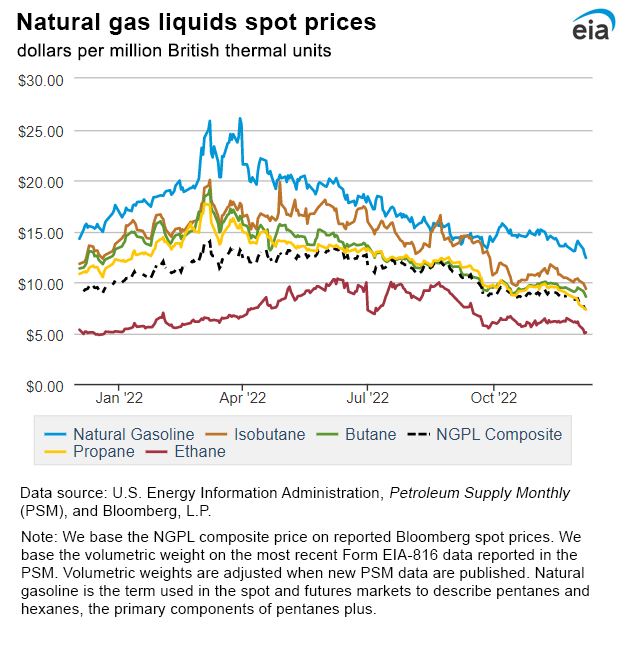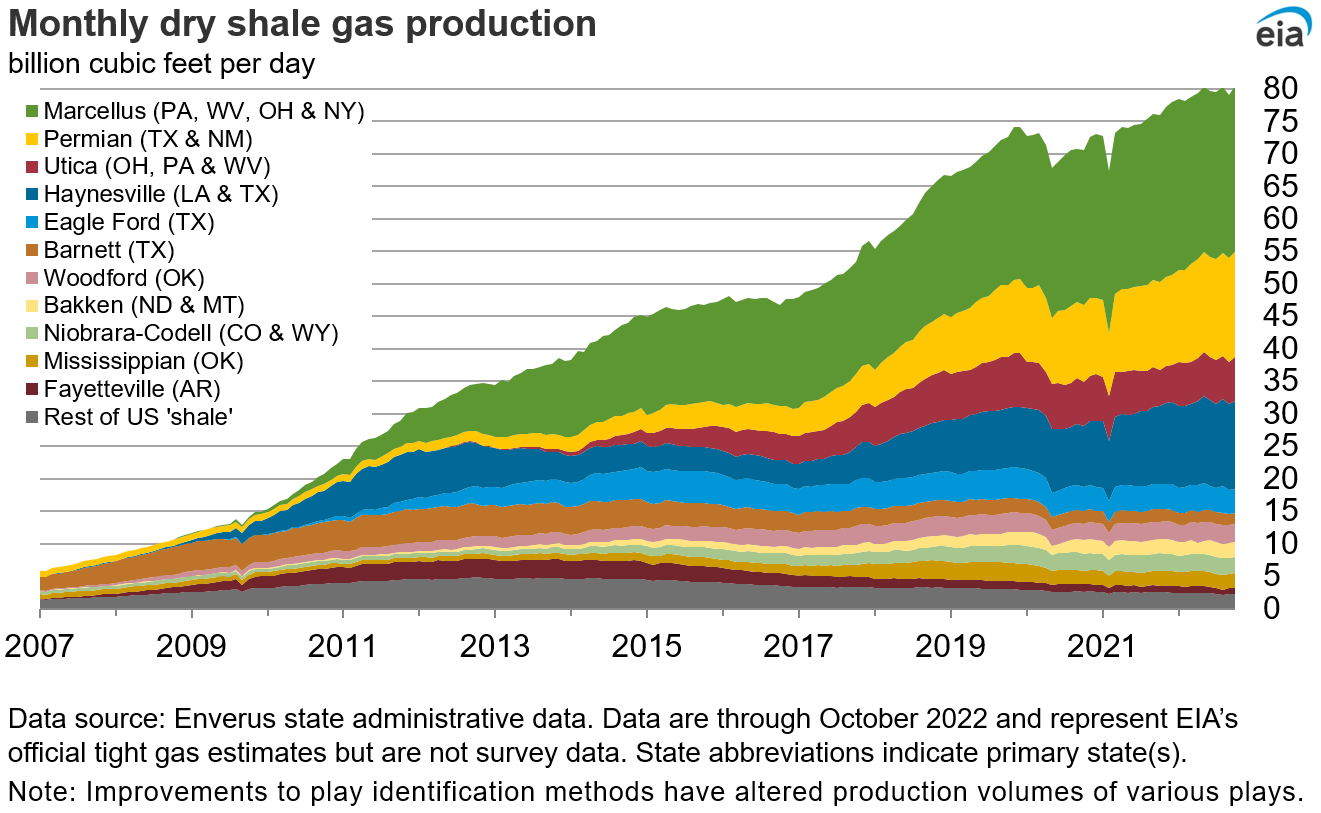In the News:
Simple-cycle natural gas turbine power plants increase capacity factor to over 20% in summer 2022
Since 2017, the average monthly capacity factor for simple-cycle natural gas turbine (SCGT) power plants has been rising; the monthly average exceeded 20% for two summer months in 2022, based on data from our November Electric Power Monthly.
SCGT power plants typically operate year round but are most active during the summer months (June–August), when electricity demand reaches its peak and varies the most. As a result, simple-cycle plants may operate as much as 20% of the time during the summer. The average monthly capacity factor during the rest of the year falls to around 10% due to lower electricity demand and more consistent electricity output from wind turbines.
SCGT power plants, which burn natural gas in a single turbine to produce electricity, are the second-largest source of natural gas-fired power generation in the United States behind combined-cycle natural gas turbine (CCGT) power plants. SCGT power plants are less efficient and require more fuel per unit of output compared with CCGT power plants because CCGT plants capture excess heat from the combustion process and deliver that heat to a steam turbine to produce additional energy.
The advantage of SCGT power plants for an electric grid operator is that operators can use them to respond quickly to fluctuating demand for electricity. The need for more electricity grid support during the day is growing as a result of larger amounts of wind and solar capacity entering service and the possibilities of constraints in wind or solar output based on daily weather conditions. SCGTs are well suited to provide that grid support because they can produce electricity quickly to immediately fill gaps in electricity output on the grid and then ramp down just as quickly. Other natural gas-fired electricity generators, such as combined-cycle or steam boiler plants, can take two to three times longer than SCGT power plants to start and ramp-up to full load.
U.S. SCGT operating capacity was 132,861 megawatts (MW) in September 2022, based on our latest Electric Power Monthly. SCGT capacity has been gradually rising since 2020, with an estimated 2,121 MW of new capacity entering service in 2021 and another 1,196 MW expected in 2022. Close to half of the capacity added in 2021 and 2022 is in Texas, due to its need for more fast-starting generating capacity to meet rising power demand and for greater variability in supply.
New battery energy storage systems (BESS) may displace some of the generation from SCGT power plants. Currently, 7,115 MW of BESS capacity is in service today, but we expect that capacity to double by September 2023, based on our Electric Power Monthly.
Market Highlights:
(For the week ending Wednesday, December 7, 2022)Prices
- Henry Hub spot price: The Henry Hub spot price fell $2.27 from $6.80 per million British thermal units (MMBtu) last Wednesday to $4.53/MMBtu yesterday.
- Henry Hub futures prices: The price of the January 2023 NYMEX contract decreased $1.207, from $6.930/MMBtu last Wednesday to $5.723/MMBtu yesterday. The price of the 12-month strip averaging January 2023 through December 2023 futures contracts declined 67.7 cents to $5.032/MMBtu.
- Select regional spot prices: Natural gas spot prices were mixed this report week (Wednesday, November 30, to Wednesday, December 7). Prices in the West increased while prices in markets east and south of the Rocky Mountains fell. Week-over-week price changes at major pricing hubs ranged from an increase of $4.76/MMBtu at the Opal hub in southwest Wyoming to a decline of $5.01/MMBtu at Algonquin Citygate.
- Prices in the West, already at elevated levels for several report weeks relative to other major U.S. markets, rose above $20.00/MMBtu this week. The price at Sumas on the Canada-Washington state border rose $4.73 from $16.46/MMBtu last Wednesday to $21.19/MMBtu yesterday, while the price at Malin, Oregon, the northern delivery point into the PG&E service territory, rose $3.55 from $17.10/MMBtu last Wednesday to $20.65/MMBtu yesterday. The price at PG&E Citygate in Northern California rose $4.16, up from $16.80/MMBtu last Wednesday to $20.96/MMBtu yesterday, and the price at SoCal Citygate in Southern California increased $3.58 from $19.29/MMBtu last Wednesday to $22.87/MMBtu yesterday. Cooler weather moved south into the Pacific Northwest and California, bringing lower-than-normal temperatures to much of the region. In the Seattle City Area, temperatures averaged 38°F this week, 5°F below normal, which resulted in 34 more heating degree days (HDD) than normal, and 14 more HDDs than last week. Temperatures in the Sacramento Area averaged 46°F this week, which resulted in 134 HDDs, 19 more HDDs than normal. Consumption of natural gas in all sectors in the Western region rose week over week by 11%, or 1.3 billion cubic feet per day (Bcf/d), according to data from PointLogic. Natural gas consumption in the Western region this report week is 27% (2.8 Bcf/d) higher compared with the same week in 2021. Week-over-week natural gas flows from Canada were lower by 3% (0.1 Bcf/d) as a result of cooler weather and higher consumption in Western Canada.
- In the Northeast, at the Algonquin Citygate, which serves Boston-area consumers, the price fell $5.01 from $9.91/MMBtu last Wednesday to $4.90/MMBtu yesterday. At the Transcontinental Pipeline Zone 6 trading point for New York City, the price decreased $2.27 from $6.73/MMBtu last Wednesday to $4.46/MMBtu yesterday. In the Appalachia region, the Tennessee Zone 4 Marcellus spot price decreased $1.54 from $5.60/MMBtu last Wednesday to $4.06/MMBtu yesterday, and the price at Eastern Gas South in southwest Pennsylvania fell $1.86 from $5.86/MMBtu last Wednesday to $4.00/MMBtu yesterday. Temperatures in the Boston Area averaged 44°F this report week, 5°F above normal, leading to 34 fewer HDDs than is normal for this time of year. In the New York-Central Park Area, temperatures averaged 46°F, resulting in 26 fewer HDDs than normal. And in the Pittsburgh Area, temperatures averaged 39°F, which resulted in 16 fewer HDDs than normal.
- Most prices in West Texas fell below $1.00/MMBtu this week. The price at the Waha Hub in West Texas, which is located near Permian Basin production activities, fell $4.72 this report week, from $5.10/MMBtu last Wednesday to $0.38/MMBtu yesterday. The Waha Hub traded $4.15 below the Henry Hub price yesterday, compared with last Wednesday when it traded $1.70/MMBtu below the Henry Hub price. Reduced takeaway capacity put downward pressure on prices in West Texas this report week. Capacity on the Permian Highway Pipeline (PHP) has been reduced by 1.0 Bcf/d to 1.1 Bcf/d from December 6 through December 9, according to a maintenance notice from Kinder Morgan, operator of PHP. PHP delivers gas from West Texas to U.S. Gulf Coast and Mexico markets. Also, maintenance at El Paso Natural Gas Company’s Waha station has been extended, resulting in continued impairment of westbound natural gas flows. Net natural gas flows from West Texas, the Texas portion of the Permian Basin, decreased 3% (0.3 Bcf/d), according to data from PointLogic.
- International futures prices: International natural gas futures prices increased this report week. According to Bloomberg Finance, L.P., weekly average futures prices for liquefied natural gas (LNG) cargoes in East Asia increased $1.97 to a weekly average of $32.98/MMBtu, and natural gas futures for delivery at the Title Transfer Facility (TTF) in the Netherlands, the most liquid natural gas market in Europe, increased $2.94 to a weekly average of $42.95/MMBtu.
- Natural gas plant liquids (NGPL) prices: The natural gas plant liquids composite price at Mont Belvieu, Texas, fell 52 cents/MMBtu, averaging $7.77/MMBtu for the week ending December 7. Ethane prices fell 10%, while natural gas prices at the Houston Ship Channel fell 21%, widening the ethane premium to natural gas by 88%. Ethylene spot prices fell 9%, narrowing the ethylene to ethane premium by 8%. Propane prices fell 10%, while the weekly average price of Brent crude oil fell 3%, resulting in a 6% increase in the propane discount relative to crude oil. Isobutane prices followed crude oil prices, also falling by 3%, and the prices of normal butane and natural gasoline remained relatively unchanged.
Daily spot prices by region are available on the EIA website.
Supply and Demand
- Supply: According to data from PointLogic, the average total supply of natural gas fell by 0.6% (0.6 Bcf/d) compared with the previous report week. Dry natural gas production decreased by 0.6% (0.6 Bcf/d) to an average 100.2 Bcf/d, and average net imports from Canada were relatively unchanged from last week at 5.1 Bcf/d.
- Demand: Total U.S. consumption of natural gas rose by 8.6% (7.2 Bcf/d) compared with the previous report week, according to data from PointLogic. Natural gas consumed for power generation climbed by 8.8% (2.5 Bcf/d) week over week. Industrial sector consumption increased by 2.2% (0.5 Bcf/d) week over week, and in the residential and commercial sectors, consumption increased by 13.4% (4.2 Bcf/d). The West and Midwest regions experienced colder-than-normal temperatures this week. Natural gas exports to Mexico decreased 3.0% (0.2 Bcf/d). Natural gas deliveries to U.S. LNG export facilities (LNG pipeline receipts) averaged 11.8 Bcf/d, or 0.2 Bcf/d higher than last week.
Liquefied Natural Gas (LNG)
- Pipeline receipts: Overall natural gas deliveries to U.S. LNG export terminals increased by 0.2 Bcf/d week over week to average 11.8 Bcf/d this report week, according to data from PointLogic. Natural gas deliveries to LNG export terminals in South Louisiana decreased by 0.1 Bcf/d to 8.4 Bcf/d, while natural gas deliveries to other LNG terminals increased by a combined 0.3 Bcf/d to 3.4 Bcf/d.
- Vessels departing U.S. ports: Twenty-three LNG vessels (nine from Sabine Pass, four each from Cameron and Corpus Christi, three from Calcasieu Pass, two from Cove Point, and one from Elba Island) with a combined LNG-carrying capacity of 85 Bcf departed the United States between December 1 and December 7, according to shipping data provided by Bloomberg Finance, L.P. Seven more vessels departed the United States this week compared with last week. Ship loadings were lower last week as a result of pilot services on Gulf Coast waterways being suspended or reduced due to fog.
Rig Count
- According to Baker Hughes, for the week ending Tuesday, November 30, the natural gas rig count remained the same as a week ago at 155 rigs. The number of oil-directed rigs also remained the same as last week at 627 rigs, although there were changes within the producing areas. The Arkoma Woodford, the Cana Woodford, and an unidentified producing region each added one rig. The Permian dropped two rigs, and the Ardmore Woodford dropped one rig. The total rig count, which includes 2 miscellaneous rigs, stands at 784 rigs, 215 more rigs than the same week last year.
Storage
- The net withdrawals from storage totaled 21 Bcf for the week ending December 2, compared with the five-year (2017–2021) average net withdrawals of 49 Bcf and last year's net withdrawals of 59 Bcf during the same week. Working natural gas stocks totaled 3,462 Bcf, which is 58 Bcf (2%) lower than the five-year average and 51 Bcf (1%) lower than last year at this time.
- According to The Desk survey of natural gas analysts, estimates of the weekly net change to working natural gas stocks ranged from net withdrawals of 11 Bcf to 46 Bcf, with a median estimate of 24 Bcf.
Other Market Drivers
- In response to mild weather and relatively low natural gas demand in the Northeast, both Texas Eastern Transmission, LP (TE) and Transcontinental Gas Pipeline Company (Transco) issued operational notices this week to manage natural gas flows on their pipeline systems. On December 5, TE issued an operational advisory restricting injections of natural gas into storage, effective December 6; the advisory was lifted, effective December 8. To manage system imbalances and ensure shippers maintain a concurrent balance of natural gas deliveries and receipts, Transco issued an operational flow order, effective December 7 until further notice.
See also:
Top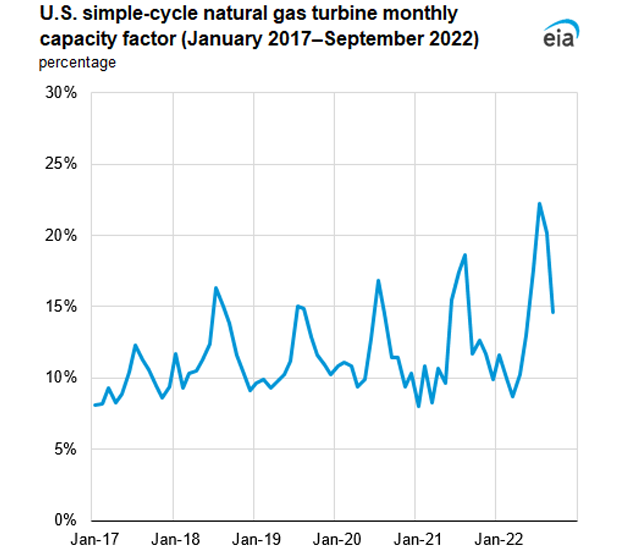
Data source: U.S. Energy Information Administration, Electric Power Monthly, November 2022
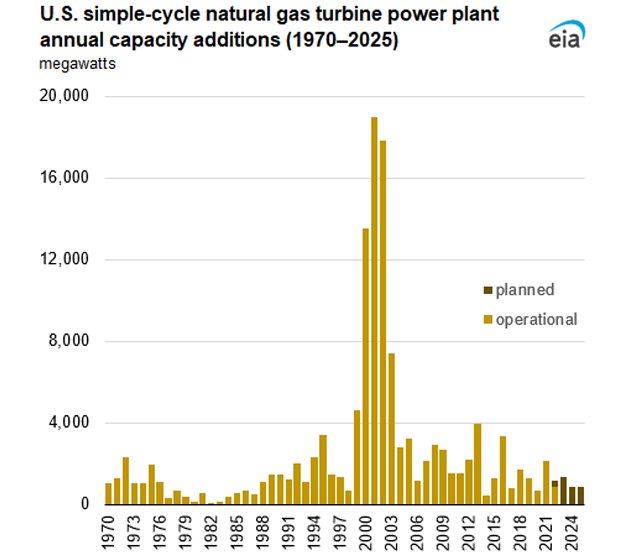
Data source: U.S. Energy Information Administration, Electric Power Monthly, November 2022
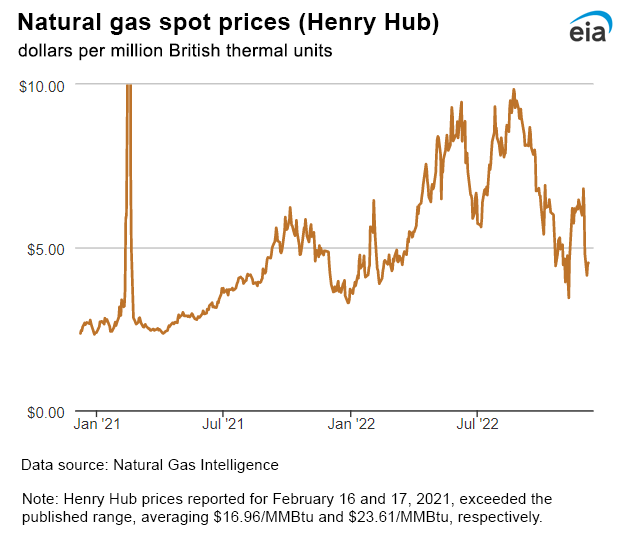
| Spot Prices ($/MMBtu) | Thu, 01-Dec |
Fri, 02-Dec |
Mon, 05-Dec |
Tue, 06-Dec |
Wed, 07-Dec |
|---|---|---|---|---|---|
| Henry Hub |
6.22 |
4.82 |
4.14 |
4.46 |
4.53 |
| New York |
5.65 |
5.21 |
3.95 |
3.95 |
4.46 |
| Chicago |
5.57 |
4.50 |
4.37 |
4.31 |
4.30 |
| Cal. Comp. Avg.* |
18.76 |
14.90 |
17.51 |
17.43 |
20.99 |
| Futures ($/MMBtu) | |||||
| January contract | 6.738 |
6.281 |
5.577 |
5.469 |
5.723 |
| February contract |
6.631 |
6.169 |
5.484 |
5.378 |
5.617 |
| Data source: Natural Gas Intelligence and CME Group as compiled by Bloomberg, L.P. *Avg. of NGI's reported prices for: Malin, PG&E Citygate, and Southern California Border Avg. |
|||||
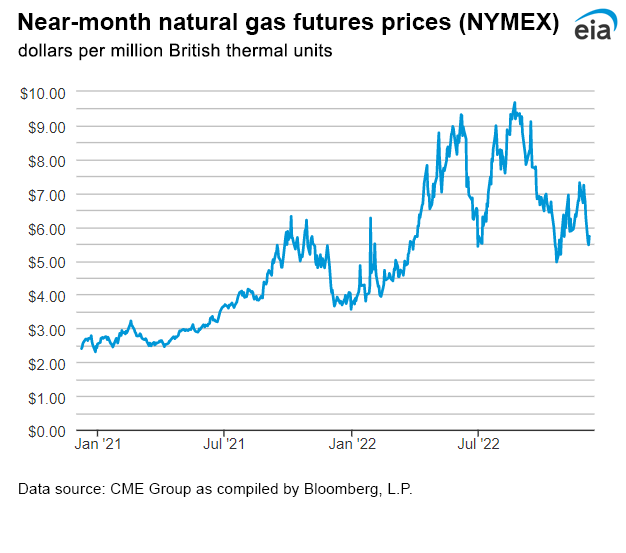
| U.S. natural gas supply - Gas Week: (12/1/22 - 12/7/22) | |||
|---|---|---|---|
Average daily values (billion cubic feet) |
|||
this week |
last week |
last year |
|
| Marketed production | 112.4 |
113.0 |
108.1 |
| Dry production | 100.2 |
100.8 |
96.5 |
| Net Canada imports | 5.1 |
5.1 |
5.2 |
| LNG pipeline deliveries | 0.1 |
0.1 |
0.1 |
| Total supply | 105.4 |
106.0 |
101.8 |
|
Data source: PointLogic | |||
| U.S. natural gas consumption - Gas Week: (12/1/22 - 12/7/22) | |||
|---|---|---|---|
Average daily values (billion cubic feet) |
|||
this week |
last week |
last year |
|
| U.S. consumption | 90.7 |
83.5 |
81.9 |
| Power | 30.7 |
28.2 |
27.9 |
| Industrial | 24.6 |
24.1 |
24.2 |
| Residential/commercial | 35.4 |
31.2 |
29.8 |
| Mexico exports | 5.6 |
5.7 |
5.7 |
| Pipeline fuel use/losses | 7.4 |
7.2 |
6.9 |
| LNG pipeline receipts | 11.8 |
11.6 |
11.8 |
| Total demand | 115.5 |
108.1 |
106.4 |
|
Data source: PointLogic | |||
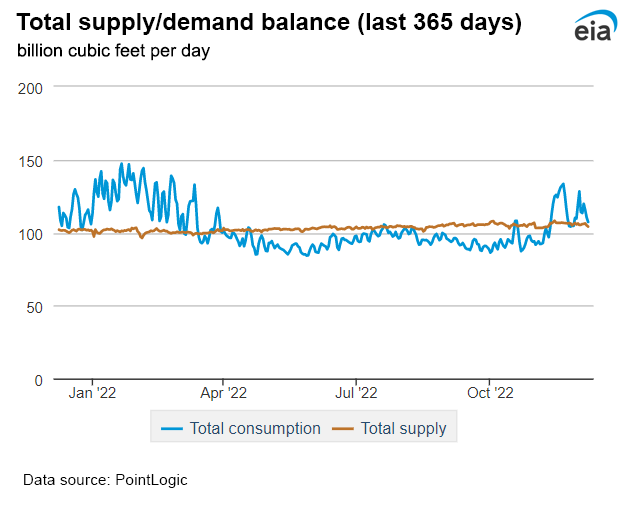
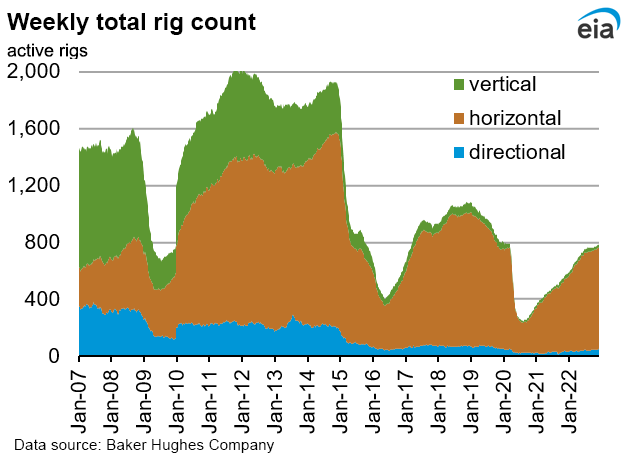
| Rigs | |||
|---|---|---|---|
Tue, November 29, 2022 |
Change from |
||
last week |
last year |
||
| Oil rigs | 627 |
0.0% |
34.3% |
| Natural gas rigs | 155 |
0.0% |
52.0% |
| Note: Excludes any miscellaneous rigs | |||
| Rig numbers by type | |||
|---|---|---|---|
Tue, November 29, 2022 |
Change from |
||
last week |
last year |
||
| Vertical | 25 |
8.7% |
0.0% |
| Horizontal | 711 |
-0.4% |
38.6% |
| Directional | 48 |
2.1% |
54.8% |
| Data source: Baker Hughes Company | |||
| Working gas in underground storage | ||||
|---|---|---|---|---|
Stocks billion cubic feet (Bcf) |
||||
| Region | 2022-12-02 |
2022-11-25 |
change |
|
| East | 834 |
840 |
-6 |
|
| Midwest | 1,028 |
1,040 |
-12 |
|
| Mountain | 193 |
197 |
-4 |
|
| Pacific | 217 |
226 |
-9 |
|
| South Central | 1,191 |
1,181 |
10 |
|
| Total | 3,462 |
3,483 |
-21 |
|
| Data source: U.S. Energy Information Administration Form EIA-912, Weekly Underground Natural Gas Storage Report | ||||
| Working gas in underground storage | |||||
|---|---|---|---|---|---|
Historical comparisons |
|||||
Year ago (12/2/21) |
5-year average (2017-2021) |
||||
| Region | Stocks (Bcf) |
% change |
Stocks (Bcf) |
% change |
|
| East | 846 |
-1.4 |
852 |
-2.1 |
|
| Midwest | 1,022 |
0.6 |
1,023 |
0.5 |
|
| Mountain | 206 |
-6.3 |
205 |
-5.9 |
|
| Pacific | 266 |
-18.4 |
284 |
-23.6 |
|
| South Central | 1,173 |
1.5 |
1,157 |
2.9 |
|
| Total | 3,513 |
-1.5 |
3,520 |
-1.6 |
|
| Data source: U.S. Energy Information Administration Form EIA-912, Weekly Underground Natural Gas Storage Report | |||||
| Temperature – heating & cooling degree days (week ending Dec 01) | ||||||||
|---|---|---|---|---|---|---|---|---|
HDDs |
CDDs |
|||||||
| Region | Current total |
Deviation from normal |
Deviation from last year |
Current total |
Deviation from normal |
Deviation from last year |
||
| New England | 172 |
-22 |
-42 |
0 |
0 |
0 |
||
| Middle Atlantic | 161 |
-23 |
-35 |
0 |
0 |
0 |
||
| E N Central | 190 |
-22 |
-23 |
0 |
0 |
0 |
||
| W N Central | 222 |
-16 |
33 |
0 |
0 |
0 |
||
| South Atlantic | 101 |
-26 |
-42 |
15 |
5 |
11 |
||
| E S Central | 110 |
-21 |
-37 |
0 |
-1 |
0 |
||
| W S Central | 89 |
-7 |
10 |
1 |
-3 |
-1 |
||
| Mountain | 212 |
9 |
70 |
0 |
0 |
-1 |
||
| Pacific | 114 |
9 |
62 |
0 |
-1 |
0 |
||
| United States | 154 |
-13 |
2 |
3 |
1 |
2 |
||
|
Data source: National Oceanic and Atmospheric Administration Note: HDDs=heating degree days; CDDs=cooling degree days | ||||||||
Average temperature (°F)
7-day mean ending Dec 01, 2022
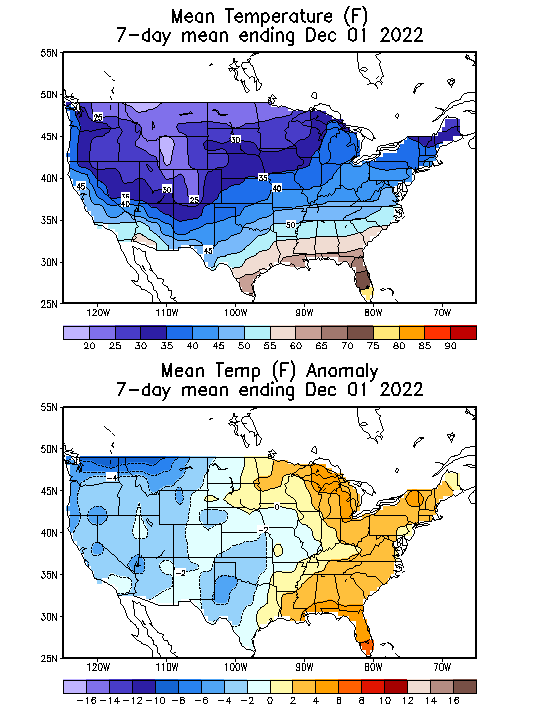
Data source: National Oceanic and Atmospheric Administration
Deviation between average and normal temperature (°F)
7-day mean ending Dec 01, 2022

Data source: National Oceanic and Atmospheric Administration

